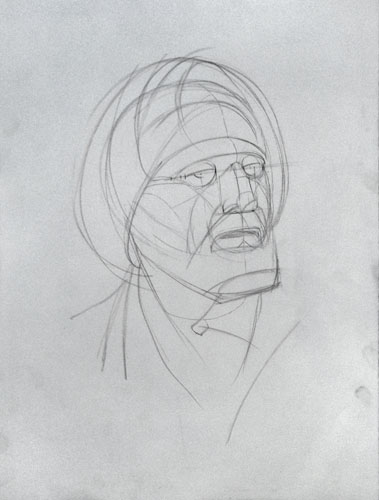About Nathan Fowkes

I do concept art, color and lighting design for animation and entertainment projects, notable clients include DreamWorks, Blue Sky, Disney and Digital Domain.
It’s a great job but since everything is painted digitally I spend my own time painting with traditional mediums, these paintings and sketches are the emphasis my blog. I’ll post my digital work where possible as well as classroom demonstrations for the benefit of my art students.
Learn more about Nathan below
Drawing the Portrait from Life Video Course
Drawing a Portrait with Charcoal Step by Step

This demo will specifically address the challenges of representational life drawing.

Step 1
A construction drawing that emphasizes the simple geometry of the head and helps properly fit the parts into the whole. For you 3-d guys out there, think wire frame.

Step 2
Add darks in the features and important lines so as to not loose them as the drawing progresses.

Step 3
Block in the big simple masses of light and shadow. No detail yet! Most artists use the term “value” for the relative lightness or darkness of the tones they put down. That’s the term I’ll use here as well.

Step 4
Work the halftones into the light. Wrap your strokes around the forms to help the illusion of 3-D. No mindless details! Make sure every tone you put down usefully describes the underlying form. I’m using my fingers alot in this particular drawing but technique is not nearly as important as getting the right value in the right place. Pencil strokes, tissues, blending stumps, bristle brushes, finger smudging and anything else you can think of can be useful techniques.

Final stage
Add highlights and refine the drawing (I’m using a kneaded eraser at this stage). Always compare highlights to each other to judge their relativebrightness. For instance, a highlight on a clean shavenchin may look very bright in contrast to the dark shadows surrounding it but don’t be fooled. It will almost never be as bright as highlights on the cheek and forehead. The values of light and shadow must always maintain proper relationships to each other. Ignore this and you’ll end up with something like the image below.

Ughh is right, and yet I have never once had a student in my nine years of teaching whose value drawings didn’t tend to drift in this direction. Why? Because it’s how our brains are wired. We, all of us, most strongly notice “that which varies” (details, contrasts, anatomical bumps, highlights, wisps of hair, etc). And so we unconsciously give these variations undue emphasis which leads to bumpy, out of control drawings like the one above. (Such drawings might get an occasional compliment like “it’s very expressive” or “It’s a very rugged caricature” but these results are completely accidental and don’t come out of any studiedskillfulness or artistic intent, watch out!). Don’t let yourself be derailed by this stumbling block. These tricks of perception are, in my experience, why so few hardworking students ever develop a full mastery of drawing from life.

But you can avoid the bad drawing problem by seeking the “simplified statement”. Compare the above “bad” drawing to this one: Ahhh, much better. You can put all the fancy, splashy technique you want into a representational drawing or painting IF it’s used to emphasize clear values of light and shadow and the three dimensional nature of the subject.
For this image I fussed with the original drawing inphotoshop to get the utmost simplicity in how the parts properly relate to each other and the whole.
I hope you enjoyed this article on Drawing a Portrait with Charcoal by Artist Nathan Fowkes. Be sure to visit Nathan’s Website below to learn more about him:
Loved the article. Nice step by step lesson. Thanks alot! will visit Nathan’s site.
great stuff! visited nathan’s site masterpiece work and great inspiration. thanks a ton
One word … actually 2 words!
Amazing!
and
Thanks
Would love to draw like this!
Great charcoal portrait.thank you.